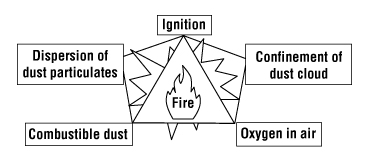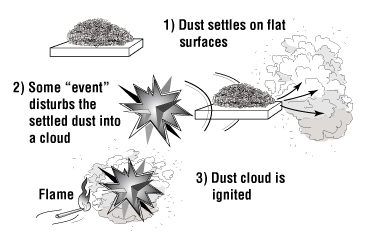Combustible Dust
From our friends at: Canadian Centre for Occupational Health and Safety
https://www.ccohs.ca/oshanswers/chemicals/combustible_dust.html
Combustible Dust
What is a combustible dust?
Essentially, a combustible dust is any fine material that has the ability to catch fire and explode when mixed with air. Combustible dusts can be from:
- most solid organic materials (such as sugar, flour, grain, wood, etc. )
- many metals, and
- some nonmetallic inorganic materials.
Some of these materials are not "normally" combustible, but they can burn or explode if the particles are the right size and in the right concentration.
Therefore any activity that creates dust should be investigated to see if there is a risk of that dust being combustible. Dust can collect on surfaces such as rafters, roofs, suspended ceilings, ducts, crevices, dust collectors, and other equipment. When the dust is disturbed and under certain circumstances, there is the potential for a serious explosion to occur. The build-up of even a very small amount of dust can cause serious damage.
What is the technical definition for combustible dust?
The technical definitions for combustible dust vary. In Canada, the Hazardous Products Regulation (WHMIS 2015) defines combustible dust as " a mixture or substance that is in the form of finely divided solid particles that, upon ignition, is liable to catch fire or explode when dispersed in air".
Another example is Alberta's Occupational Health and Safety Code which defines combustible dust as "a dust that can create an explosive atmosphere when it is suspended in air in ignitable concentrations".
The Occupational Safety and Health Administration (OSHA) in the United States defines combustible dust as "a solid material composed of distinct particles or pieces, regardless of size, shape, or chemical composition, which presents a fire or deflagration hazard when suspended in air or some other oxidizing medium over a range of concentrations".
What are examples of materials that can be a combustible dust hazard?
Many materials can become combustible under specific situations. Examples include:
- agricultural products such as egg whites, powdered milk, cornstarch, sugar, flour, grain, potato, rice, etc.
- metals such as aluminum, bronze, magnesium, zinc, etc.
- chemical dusts such as coal, sulphur, etc.
- pharmaceuticals
- pesticides
- rubber
- wood
- textiles
- plastics
There are many, many more types of materials that may become a combustible dust. The US OSHA has created a poster which lists more examples.
What workplaces are at risk for a dust explosion?
Dust explosions have occurred in many different types of workplaces and industries, including:
- Grain elevators,
- Food production,
- Chemical manufacturing (e.g. , rubber, plastics, pharmaceuticals),
- Woodworking facilities,
- Metal processing (e.g. , zinc, magnesium, aluminum, iron),
- Recycling facilities (e.g. , paper, plastics, metals), and
- Coal-fired power plants.
Dusts are created when materials are transported, handled, processed, polished, ground and shaped. Dusts are also created by abrasive blasting, cutting, crushing, mixing, sifting or screening dry materials. The buildup of dried residue from the processing of wet materials can also generate dusts. Essentially, any workplace that generates dust is potentially at risk.
How do combustible dust explosions happen?
Any fire needs three elements. These elements are known as the "fire triangle":
1. Fuel to burn2. Oxygen
3. Ignition source (heat, spark, etc. )
A dust explosion needs two additional elements - known as the "dust pentagon":
4. Dispersion of dust particles in the right concentration, and
5. Confinement of the dust cloud.
Dispersion means the dust particles are suspended in air. Confinement means the dust is in an enclosed or limited space. This restriction allows pressure to build up, increasing the likelihood of an explosion.

Figure 1
Figure 1 shows the dust explosion pentagon. Figure from Occupational Safety and Health Administration (OSHA).
What is deflagration?
Deflagration is a term often used to describe combustible dust explosions. A deflagration is an "ordinary" fire such as a gas stove, burning wood or paper, and even the burning of gasoline vapour inside the cylinder of an automobile. In a deflagration, a burning substance releases heat, hot gases, and energetic particles or sparks that ignite and spread the fire.
In a dust explosion, the deflagration processes happens so rapidly that the heated air and gaseous fire products (such as carbon dioxide) produce extreme air pressure that can blow out walls and destroy structures.
What are primary and secondary dust explosions?
When combustible dusts ignite, there are often two explosions known as primary and secondary explosions.
The primary dust explosion is the first explosion. It occurs when there is a dust suspension in a confined space (such as a container, room, or piece of equipment) that is ignited and explodes.

Figure 2
Figure 2 shows events in a primary dust explosion. Figure from U.S. Chemical Safety and Hazard Investigation Board.
The primary explosion will shake other dust that has accumulated. When this dust becomes airborne, it also ignites. This secondary dust explosion is often more destructive than the primary one.
What conditions are needed for a dust explosion to happen?
The basic requirements for a dust explosion to occur is that combustible dusts are suspended in air and are ignited. In practice, for a dust explosion to occur, a number of conditions must be met including:
- The dust must be combustible and release enough heat when it burns to sustain the fire.
- The dust must be capable of being suspended in air.
- The dust must have a particle size capable of spreading the flame.
- The concentration of the dust suspension must be within the explosible range.
- An ignition source must be in contact with the dust suspension.
- The atmosphere must contain sufficient oxygen to support and sustain combustion.
- There is a form of confinement or enclosure that allows pressure to build.
How do I identify a combustible dust hazard?
There are many variables that must be considered - the particle size of the dust, the method of dispersion, ventilation system characteristics, air currents, ignition sources, confinement of the dust cloud, physical barriers, and so on. As a result, the often quoted "rule of thumb" about dust accumulation (such as being able to write in the dust, or the dust being the thickness of a paperclip, dime or quarter, or the amount of visibility through a dust cloud) is not always reliable.
Best practice is to keep the workplace as dust free as possible.
Conduct a risk assessment and look specifically for dust explosion possibilities. Below are some questions that may help.
Processes
- Do you manufacture or use any materials (and their by-products) that can become a dust?
- Do you have processes such as abrasive blasting, cutting, grinding, sieving, polishing, cleaning, or other tasks that create dust?
Research/Information
- Have you researched if the dust present is combustible?
- Are there documented cases reported in literature about the materials in your workplace being associated with a combustible dust explosion?
Note: It is very important to research the materials and products used in your workplace. Stating the possibility of a combustible dust hazard is a new requirement on the Safety Data Sheet (SDS). Older Material Safety Data Sheets (MSDSs) may not provide the same information so additional research may be necessary.
Ignition sources
- Do you have ignition sources (e.g. , sparks, fire/flames, stoves, kilns, or welding flames)?
- Can dust enter or accumulate on electrical enclosures or equipment?
- Does your workplace have a no-smoking policy? Are there measures to isolate smoking and ignition sources away from production areas?
Housekeeping
- Do you know if there are open areas and overhead structures where dusts may accumulate?
- Have you looked for "hidden" areas where dust may accumulate (e.g. , behind false ceilings, inside ventilation or conveyor equipment, in ducts, on support beams, etc. )?
- Do you have a housekeeping program to regularly remove dust?
- Do you have a dust collection system in place?
- If yes, does your dust collection system conform to local requirements (e.g. , fire code)?
Education and training
- Are employees aware of combustible dust and its hazards?
- Do employees follow housekeeping rules and take steps to reduce dust and remove ignition sources?
- Have employees been trained and educated on safe methods for cleaning?
What are prevention measures?
Once you have identified the hazards, you need to take prevention measures.
Eliminate
- Where possible, avoid horizontal surfaces (such as window ledges, beams, light fittings, etc. ) where dust can accumulate.
- Eliminate "hidden" areas where dust can accumulate unnoticed.
- Do not use brooms or compressed air hoses to clean surfaces. Only use vacuums approved for dust collection.
- Only use a dust collection / dust extraction system that is designed to eliminate or control combustible dust. Using most models of fans typically stirs the dust, adding dust particles into the air and worsening the situation.
Substitute
Install smooth ceilings and other surfaces (instead of a rough finish) to minimize dust accumulation and to make cleaning easier.
Engineering
- Use an appropriate dust extraction and collection system with the inlet located as close to the dust producing process as possible. Follow required standards and codes when installing these systems. Locate dust collectors outdoors, where possible.
- Direct explosion venting away from areas where there may be employees.
- Use appropriate electrical and ventilation equipment.
- Keep all mechanical and electrical equipment in good repair.
- Keep static electricity under control, which includes the bonding and grounding of equipment. Check all bonded and grounded equipment regularly to ensure the bonds are in good condition.
- Check equipment that may wear (e.g. , bearings) as they may generate heat and become an ignition source.
- Remove open flames, sparks, friction, heat sources, and other sources of ignition.
- Select and use intrinsically safe tools or machinery.
- Put covers around pipes and cables, or embed pipes and cables in the walls, where possible, to reduce surfaces where dust can accumulate.
Administration
- Develop and implement a combustible dust inspection and control program which outlines how often inspections will occur and how dust will be controlled.
- Develop a hot work permit system for activities such as welding and cutting.
- Develop an ignition control program to eliminate or reduce sources of ignition. Keep ignition sources away from dusty areas or use suitable controls.
- Educate all employees about combustible dusts, the hazards, and how they can help eliminate the risk of fire and explosions.
- Inspect for dust at regular intervals.
- Establish a housekeeping program that will remove dust regularly.
- Use proper equipment and techniques when cleaning dust. Care must be taken to minimize dust clouds, and only use vacuums approved for dust collection.
- Regularly inspect machines, ducts, and ventilation systems for dust. Repair or clean promptly.
Comments
Post a Comment